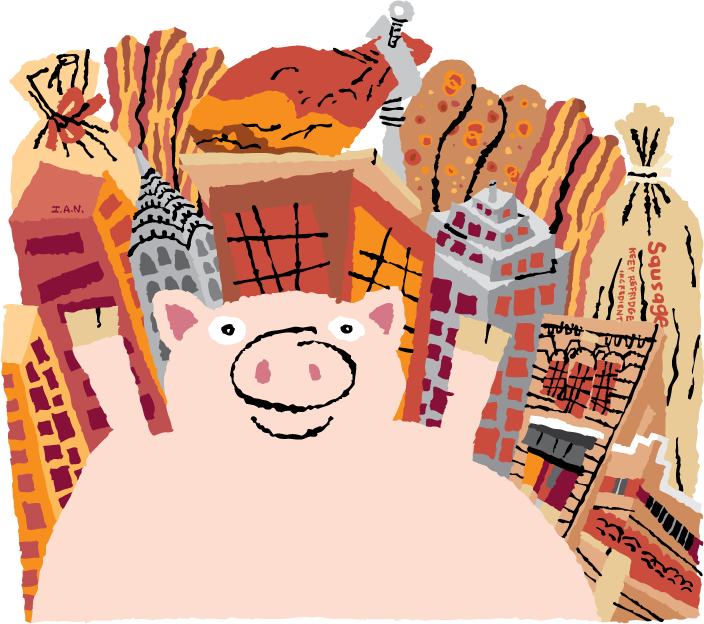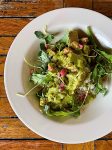An Insightful Examination of Pork and the Presidency!
Getting a bit jaded by election politics? Ready for a fresh perspective? Like history, love to laugh, appreciate good food? This article is for you! Adrian Miller will be presenting at this year’s 7th Annual Camp Bacon®. His subject: “Pork: The Perennial Dark Horse Presidential Candidate.” I’m forecasting it will help put some of those less-than-inspiring presidential debates out of your mind. And I guarantee you will know a lot more about pork and its historical presence in the White House over the past 216 years.
I first met Adrian many years ago at the Southern Foodways Alliance symposium in Oxford, Mississippi. Paul, Alex and I flew down the year before we were going to open the Zingerman’s Roadhouse. This was fall of 2002, and the theme that year was BBQ, something we were pretty sure was going to be a key piece of our menu. And as high as my initial expectations might have been, they were exceeded. The food, the people, the learning, and inspiration were all exceptional. I heard Adrian speak at the symposium that year, and then again a few years later after he’d joined the board of SFA. He caught my attention with the depth of his historical knowledge, and I laughed almost as much as I learned.
That trip was, in hindsight, a life-altering event. It was the beginning of a nearly 15-year long relationship with an amazing non-profit, and a connection with a region of the country of which, honestly, I’d previously known relatively little. Southern Foodways does fantastic work to bring together people of all backgrounds to study, share, and learn from the traditional foodways of the American South. They’ve put subjects on the table like race and food, the changing face of the South in the 21st century, the role of women, pop culture, and much more. I’ve been to just about every symposium since.
It was with all of those fantastic foods and great people in mind that we decided to create Camp Bacon® as a fundraiser for SFA seven years ago. It seemed an appropriate way to help return the generosity of spirit that we’d encountered there, and to help raise a bit of money to fund further work so that others around the country could benefit as well. If you don’t know much about SFA, by all means log onto southernfoodways.org and do some scoping. The oral histories, the short films – it’s all amazing! You can’t help but be engaged by their exceptional work.
You can also come to the 7th Annual Camp Bacon® this year and hear what Adrian Miller has to say. You might actually have already heard him—he’s been the guest speaker at two of our 11th annual African American Foodways dinners at the Roadhouse. I’ll never ever forget the feeling the night he did his “Black Chefs in the White House” event on the same exact evening of President Obama’s first inauguration. When we’d set up the event nearly a year earlier, neither of us had much thought that then Senator Obama was likely to be nominated, let alone win the general election. What a wonderful and inspiring evening! You might have read his great book, Soul Food: The Surprising Story of an American Cuisine, One Plate at a Time. If you like food and history, it’s highly recommended!
![]()

PORK: THE PERENNIAL DARK HORSE PRESIDENTIAL CANDIDATE | By Adrian Miller
Adrian Miller is an attorney, food writer, and former Special Assistant to President Bill Clinton. Adrian’s first book, Soul Food: The Surprising Story of an American Cuisine, One Plate at a Time, won the 2014 James Beard Foundation Book Award for Outstanding Reference and Scholarship. Adrian’s next book on African American presidential chefs will be published in Spring 2017.
Our presidents, from George Washington to Barack Obama, have had their share of food fights. I don’t mean that they actually threw food at other people, but they have figuratively and self-consciously used to create and maintain their public image and wrest control of it from others when necessary. It’s astonishing how fervently the American public believes that what a president likes, and dislikes, to eat somehow opens a window on the presidential soul. This is why in recent presidential memory, we’ve learned how much Ronald Reagan loved jelly beans, how much George H.W. Bush hated broccoli, when Bill Clinton jogged to a McDonald’s, how George W. Bush loves his barbecue and how Barack Obama likes to gulp down a good beer. The stakes can be high when using food to craft a presidential persona because it all comes down to getting votes, and pork has played a pivotal role in such endeavors.
You think I’m exaggerating? I offer as Exhibit 1 the case of President Martin Van Buren who was successfully tarred by his political enemies as a French food-loving elitist who used golden utensils. President Van Buren’s presidential rival, William Henry Harrison, drew a sharp contrast to the incumbent president by promoting himself as someone who loved “hog, hominy and hard cider”— a meal combination that appealed to the masses of common people. Harrison’s negative political campaign was so successful that he beat the incumbent Van Buren and won the presidency. It was the most serious case of political indigestion in presidential history. Though Harrison used pork for electoral good or evil, depending upon your perspective, pork has not received as much presidential press as other proteins. That’s mainly because pork has lost significant status in American meals since colonial times, mainly due to the growing popularity of beef.
Pork had some early advantages over beef in terms of making a regular appearance on the dining tables of European colonists. Pigs are lower maintenance animals to raise than cattle. One can feed them almost anything, they can forage for themselves in a variety of environments, they have a lot more offspring than cattle, and almost every part of their bodies can be used for some purpose after butchering. For these reasons, though beef was more highly prized, pork was more regularly utilized by colonists. Thus, in the seventeenth and eighteenth centuries, pork had a well-earned reputation for being a subsistence-level meat, a consistent source of protein even in lean times. This doesn’t mean that all pork products were considered to be poverty food. Wealthy colonists relished eating hams and pork shoulder as premium cuts of meat, and such preferences gave rise to the expression “eating high on the hog.” This was reference to where these cuts of meat were located on the pig as compared to bacon, ham hocks and the feet. It’s no wonder that pork cemented its “common person” status in the American public’s imagination, and that politicians recognized the benefits of larding their public image with references to pork. After all, the masses were mostly eating pork, or could relate to eating pork, and that’s where the votes where.
In terms of its culinary and political reputation, pork started to wane in the nineteenth century. Let’s first look at pork’s culinary status. Though beef was an uncommon treat on American tables before the 1800s, it became more widely available and cheaper thanks to advances in cattle ranching, industrial butchering and commercial transportation. Beef also became the food of successful elites—an edible example of social aspiration. This only further marginalized pork’s status as a poverty or subsistence food. As Harvey Levenstein wrote in Revolution at the Table:
“The supremacy of beef provided grist for the mills of those who complained that the middle-class American diet was too restricted… The beef and potatoes syndrome was reinforced by a disdain for pork, almost universally available in antebellum days. Here too, the middle class followed their social superiors, who shunned fresh and salted pork and deigned only to eat an occasional slice of smoked ham. Although its low price induced them to consume much more pork than it did the rich, in middle-class eyes pork ranked far below not just beef, but lamb, poultry, and game as well.”
Flip though the indexes of the existing cookbooks written by presidential chefs, and the latter point made by Levenstein is painfully true. Pork dishes usually get a few lines compared to the other meats. Even the presidential barbecue book authored by Walter Jetton, Lyndon Johnson’s barbecue-in-chief, only has a few pork recipes. Presidential food is at its best for state dinners at the White House, and beef is the overwhelming centerpiece of such meals. Pork makes an occasional appearance, but it is something that is eaten more frequently during the president’s private meals in the executive residence, out of the public spotlight.
In the nineteenth century, pork’s reputation also took a political hit because it was associated with an unseemly political practice known as “pork barrel politics.” In its earliest incarnation, the pork barrel was literally a wood barrel full of salted pork that was stored for use as needed. Though many associate its use with feeding enslaved people on plantations, the pork barrel was also used on many farms and also to feed military personnel. According to the Oxford English Dictionary, the pork barrel became a metaphor in the 1870s for the pot of government money that is set aside to pay for public projects. Soon, an odious practice arose in the U.S. Congress and state legislatures where elected officials were promised, in exchange for their votes, that money would be appropriated to pay for projects in the district they represented. The logic is that by pleasing their constituents with such projects, the elected officials would get re-elected. This was very sound logic, for many elected officials enjoyed lengthy political careers based on their ability to spend government money in their district. Thus, “pork barrel politics” was born, and symbolized government abuse and waste. In time, people dropped “barrel” and “politics,” and “pork” became short hand for bad government.
Despite the negativity thrown its way, pork has been able to rise to the culinary occasion. The following is a compilation of several great moments in presidential pork history:
January 1, 1842
President Martin Van Buren begins annual tradition of serving roast pork at New Year’s Day receptions.
Circa December 1890
Famed Kentucky cook Dollie Johnson, an African American woman, begins making sausage rolls (small sausages encased in pastry)—a favorite of First Lady Caroline Harrison.
Early 1920s
President Warren Harding grubs on knockwurst sausage and sauerkraut at stag parties he hosted at the White House for his buddies.
February 21, 1929
President Herbert Hoover changes the regular White House breakfast to bacon and eggs from the sausage and wheat cakes served in the Calvin Coolidge administration.
March 1934
“Winks,” President Franklin Delano Roosevelt’s Llewellin setter eats all of the ham and eggs breakfast set out for the White House residence staff. Winks soon left the White House to “spend more time with his family.” This event, along with others, cleared the way for Fala to become FDR’s favorite dog.
May 8, 1939
President Roosevelt, Eleanor Roosevelt, Crown Prince Frederik and Crown Princess Ingrid of Denmark dine on hot dogs for lunch.
June 10, 1939
President Roosevelt, Eleanor Roosevelt, King George VI and Queen Elizabeth of Great Britain dine on hot dogs for lunch.
Circa December 1941
President Franklin Delano Roosevelt and British Prime Minister Winston Churchill dine on sweet and sour pig’s feet at the White House. Churchill was not too pleased with the “texture” of this delicacy.
Circa 1967
A ham prepared for a White House residence staff dinner went missing. Mary Kaltman, President Lyndon Johnson’s White House Food Coordinator informed White House Chief Usher J. B. West of this predicament. At first, the employees were suspected, but no one was implicated in the crime. A few months later, an awful smell emanated from the staff dining room, but no one could pinpoint the source. Eventually, the White House engineers removed the paneling from one of the dining room walls to discover a decomposing ham bone. Those involved quickly surmised that some rats must have dragged it off the table and absconded with the ham.
December 1, 1975
The organizers of the annual Salley (South Carolina) Chitlin Strut sent five pounds of uncooked, frozen chitlins (pig intestines) to President Gerald Ford.
2000s
President George W. Bush regularly gets takeout from his favorite Texas barbecue joints for the ride on Air Force One from his ranch in Crawford, Texas back to Washington, D.C.




Zingerman’s Art for Sale